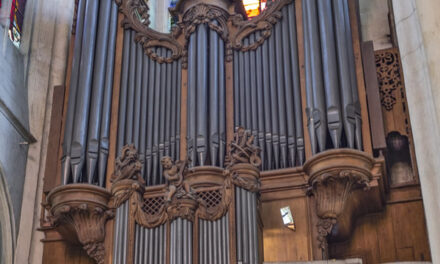The intimate space of the Altamont Theatre in Asheville was the perfect setting for this recital of string duos by violinist Christian Aldridge and cellist Elizabeth Gergel, courtesy of Pan Harmonia. Despite a pouring rain many came to hear these two young talents, both of whom are products of the University of South Carolina. Their program was challenging, but aesthetically pleasing and performed with a high degree of poise and musicality. It was moving to see such a nice crowd turn out to hear them, especially to honor Gergel, an Asheville native, who turned 21 on this day. Credit goes to Kate Steinbeck, Artistic Director of Pan Harmonia, who keeps her ear tuned to the artistic pulse of our region and provides such great opportunities for both artists and audience.
Elizabeth Gergel, a rising junior at the University of South Carolina, is already garnering an impressive set of credentials. Last March she performed in the collegiate cello masterclass at the American String Teacher Association National Conference for Lawrence Lesser of the New England Conservatory. She currently performs with the Symphony Orchestra of Augusta, the Long Bay Symphony in Myrtle Beach, and the USC Symphony Orchestra. She also serves on the teaching faculty of USC Suzuki Strings and the USC Community Music School.
A native of Fredericksburg, Virginia, and a graduate of the University of South Carolina, Christian Aldridge will enter Louisiana State University’s Master’s degree program in the fall to study with Dr. Lin He. He is also a member of the Long Bay Symphony and regularly appears with the South Carolina Philharmonic. He has performed in masterclasses with Anne Akiko Meyers, David Kim, Vadim Gluzman, and Kimberly Fisher, among others.
The program opened with Duet in F, WoO 27, No. 2, the second of a set of three duets originally for clarinet and bassoon by Beethoven (though it’s likely a spurious work). All that is really known of these works is that they were printed in Paris between 1810 and 1815. In three movements and firmly in classical style, the piece presented few problems for these players, who uniformly produced singing tones, lovely lines, and a sure handling of each part.
The piano repertoire of Béla Bartók was the source of the next set of seven short Hungarian Dances arranged for violin and cello by Karl Krautner. Characterized by asymmetrical phrases, dissonances, drones, repetitive motives, and deep soulfulness, the works work very well on strings and were a delightful contrast to the sounds of classical string music heard previously. Especially well executed were the Moderato and the Choral-Andante movements where each player maximized the lyrical beauty and soulful quality of Bartók’s writing.
Ending the first half was the Passacaglia on a Theme by Handel, arranged by Johan Halvorsen (1864-1935), a Norwegian composer, conductor, and violinist. The first two variations brought the biggest sounds from the cellist, who seemed determined that we not miss the foundation for the work. Thereafter, each variation revealed a good attention to detail with ample contrasts in dynamics and technical facility. Of particular note were the variations featuring a dialog between violin and cello, a beautifully matched musical conversation.
Following intermission came another classically styled work, the Duet in C, Op. 31, No. 1, by Federico Fiorillo (1753-1825), which exists as a work either for two violins or for violin and cello. The first movement Allegro spiritoso was played elegantly and effortlessly, although there were a few issues with subordinating the “accompanying” voice to the “principal” voice. The second movement Larghetto, stile antico featured a quaintly “archaic” walking bass to the violin’s prominent, singing melody. The third movement Allegretto scherzoso was a light closer, tossed off easily with a touch of Haydnesque humor.
The final pieces were three movements from Jeremy Cohen’s Stylistic Duets for violin and cello. Jazz violinist and composer Cohen (b. 1957), who leads the Quartet San Francisco, is much admired by these two performers who dug into each movement with relish. “Comme Il Faut” and “Tango Eight” both featured the same infectious tango rhythms, whereas “Superspy” was a fusion of rock, groove, and jazz, all permeating from the rhythmic ostinato heavily laid down by the cello. It was over-the-top fun and played as such. For an encore, the duo chose “Tipsy” (to celebrate Elizabeth’s birthday), the last movement from the same Cohen suite, and played with just the right amount of rubato/accelerando/ritardando to give the impression of celebratory lurching and reeling. Bravo tutti!












